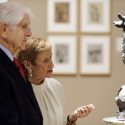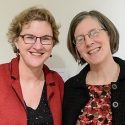Special exhibitions mark opening of Chazen Museum’s new building
The Chazen Museum of Art will celebrate the opening of its new 86,000-square-foot building and its expanded role as a hub for the arts on the University of Wisconsin–Madison campus and a leading cultural resource for the region on Oct. 22.
Three special exhibitions will inaugurate the new galleries in the addition designed by Machado and Silvetti Associates: “Sean Scully Paintings and Watercolors,” featuring several of the artist’s new large-scale abstract paintings as well as previously unexhibited watercolors from his personal collection; “Discerning Taste: Paintings from the Simona and Jerome A. Chazen Collection,” including late-20th century American and European abstract paintings by artists such as David Hockney, Robert Motherwell, Hans Hofmann, and Gerhard Richter; and “The Leslie and Johanna Garfield Collection: A Passion for Prints,” showcasing one of the most comprehensive collections of 20th-century prints in the United States.
“The expansion of the Chazen Museum of Art creates greater opportunities to fulfill our mission both as a vibrant place for learning and inspiration for students and faculty and as a cultural destination in Madison,” says Russell Panczenko, director of the Chazen Museum of Art. “The inaugural exhibitions will allow museum visitors to experience great art through the eyes of collectors, and to see works that have never been shown publicly. We are especially pleased to present the collections of the Chazens and Garfields, all University of Wisconsin alumni.”
The $43-million building will add 22,500 square feet of new gallery space on a site adjacent to the current facility — more than doubling the current exhibition space and increasing access to the museum’s collections, as well as providing more space for programs serving the campus and the community.
When the expanded museum opens its doors a substantial reinstallation of its collections will be unveiled, with many previously unseen works put on view throughout the new building’s 16,000 square feet devoted to the permanent collection.
New galleries will be dedicated to African, Asian, Midwest regional, modern, and contemporary art, replacing or expanding smaller spaces in the current building. Important works that have been stored for years due to space restrictions in the current facility will now be made accessible to the public. The current building’s third-floor continues to hold historical European and American art, and those galleries are easily reached by the bridge between the buildings.
Visitors will be reacquainted with treasured works and will be able to engage with a range of new acquisitions. The campaign for the expansion spurred donations to facilitate growth in the collections, adding more than 400 works through direct gifts and supporting acquisitions.
This includes a gift from Alvin and Terese Lane comprising more than 70 sculptures and 250 preparatory drawings by artists including Jean Arp, Alexander Calder, Louise Nevelson, Pablo Picasso, and David Smith, among other modern masters. Other recent acquisitions and promised gifts include “Three Standing Figures” from 1953 by Henry Moore; “Fools’ Congress # 2” by Arnie Zimmerman; “In Grandfather’s Arms” painted in the late 19th century by Jozef Israëls; an African Numuma (Burkina Faso) Crocodile Mask of the first quarter of the 20th century; a Chinese Jin Dynasty Cizhou Ware Tiger Pillow; Beth Cavener Stichter’s recent clay sculpture “A Rush of Blood to the Head;” several pieces of contemporary studio glass; and seven contemporary Japanese ceramics.
Inaugural exhibitions
“Sean Scully Paintings and Watercolors,” Oct. 22-Jan. 15, 2012, The Pleasant T. Rowland Galleries
Sean Scully is one of the most significant and influential abstract painters working today. He was born in Dublin and raised in a working-class Irish Catholic community in London. On a trip to Morocco he was moved by the beauty of djelleba robes, kilim rugs, and tents made of strips of wool and canvas. Scully has since become best known for his paintings of lines, stripes, and blocks of color. The exhibition of large-scale work—some painted for this exhibition—and a selection of never-before-exhibited watercolors from the artist’s personal collection will inaugurate the Pleasant T. Rowland Galleries on the expansion’s main floor.
The exhibition features works from a new series of paintings on aluminum panels, a technique that affords the artist a greater sense of control and allows for tight, clean edges. Within each panel is a smaller “passenger painting” (a painting embedded within the larger painting). The Museum has also purchased a new painting, “Cut Ground Blue Pink Red,” 2011, which will be showcased alongside these works.
“Discerning Taste: Paintings from the Simona and Jerome A. Chazen Collection,” Oct. 22–March 11, 2012, Gallery XIII, in memory of Ruth and George W. Mead I
The relationship between a work of art and the private collector is direct and personal – and the Chazens’ primary criterion in acquiring paintings has always been beauty or appeal to the “eye.” This freedom is particularly enviable when it results in a truly outstanding collection like the Chazens’. Though their interests are broad, their collection of paintings is especially noteworthy and includes some of the most beautiful work by the most important artists of the twentieth century. This exhibition of mostly late-twentieth-century American and European abstract paintings includes works by such artists as David Hockney, Robert Motherwell, Hans Hofmann, and Gerhard Richter.
Key Works from the Chazen collection include Robert Motherwell, “Elegy to the Spanish Republic #125 “ (1972); David Hockney, “The Sixteenth V.N. Painting” (1992); Roy Lichtenstein, “Two Figures” (1977); Gerhard Richter, “Abstract Painting No. 623” (1987).
“The Leslie and Johanna Garfield Collection: A Passion for Prints, Oct. 22–Jan. 15, 2012, The Leslie and Johanna Garfield Gallery
During six decades of collecting, Leslie and Johanna Garfield have acquired a rich selection of prints by German Expressionist artists, British printmakers of the Grosvenor School, American Provincetown printmakers, and contemporary masters such as Jasper Johns, David Hockney, and Richard Hamilton. This exhibition traces the development of their collection and will be on view in the new building’s second-floor gallery named in honor of their generous sponsorship.
About the expansion
The addition enhances and pays homage to the Museum’s original Harry Weese–designed building. The two structures, connected via a third-floor gallery bridge, frame a section of a new north-south pedestrian mall that runs through the heart of the university’s east campus. A floor-to-ceiling glass mezzanine along the north side of the bridge provides a dramatic view that extends from the new Museum plaza to Lake Mendota. The expanded facility will offer visitors new opportunities to view and engage with the more than 20,000 works in the Museum’s collections, including additional rooms for studying objects and works on paper. A sweeping new lobby will double as a venue for art installations and performances.
The new building echoes the stonework and strong lines of the existing architecture, creating a contiguous façade as well as a unified interior gallery plan. Weese was an exponent of the period’s classical approach, and the addition reflects elements of his original design with a limestone-clad exterior and copper roof and trim that mimic the aesthetics and materials of the existing building’s façade. The new exterior stone-block pattern evolves from a flat form and finish to a fluted, curved shape to the rough-hewn stone of the current building.
Other features of the new building include a two-story, glass-walled entrance lobby with a limestone “carpet” that rises to the galleries on the third floor; a 160-seat auditorium; increased object storage space; two glass-walled galleries; a new basement studio classroom with natural light from above; a new museum store and new outdoor courtyard spaces that connect to a new pedestrian mall on the campus’ north-south corridor.
The Chazen Museum of Art’s expansion was supported in part by a $25-million gift from University of Wisconsin alumni Simona and Jerome A. Chazen in 2005. Formerly known as the Elvehjem Museum of Art, the institution was renamed in honor of the Chazens. The remainder of the capital campaign was completed with the support of more than 140 donors, including alumni as well as supporters in Madison.


